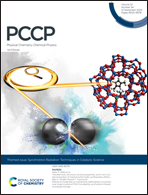On-the-fly determination of active region centers in adaptive-partitioning QM/MM†
Abstract
Quantum mechanics/molecular mechanics (QM/MM) methods are widely used in molecular dynamics (MD) simulations of large systems. By partitioning the system into active and environmental regions and treating them with different levels of theory, QM/MM methods achieve accuracy and efficiency at the same time. Adaptive-partitioning (AP) QM/MM allows the partition of the system to change during the MD simulation, making it possible to simulate processes in which the active and environmental regions exchange atoms or molecules, such as processes in solutions or solids. AP-QM/MM methods usually partition the system according to distances to centers of active regions. For energy-conserving AP-QM/MM methods, these centers are chosen beforehand and remain fixed during the MD simulation, making it difficult to simulate processes in which active regions may occur or vanish. In this paper, I develop an adaptive-center (AC) method that allows on-the-fly determination of the centers of active regions according to any geometrical criterion or any criterion dependent on the potential energy. The AC method is compatible with all existing energy-conserving AP-QM/MM methods, and the resulting potential energy surface is smooth. The application of the AC method is demonstrated with two examples in solid systems.



 Please wait while we load your content...
Please wait while we load your content...